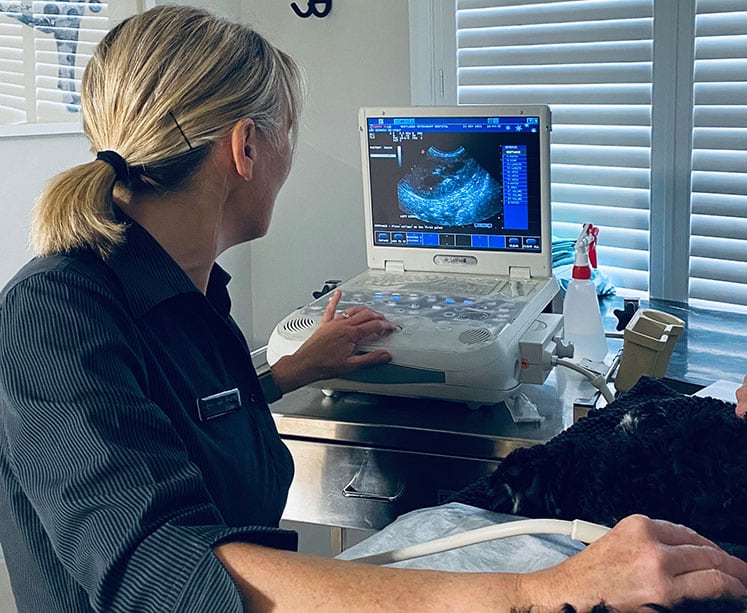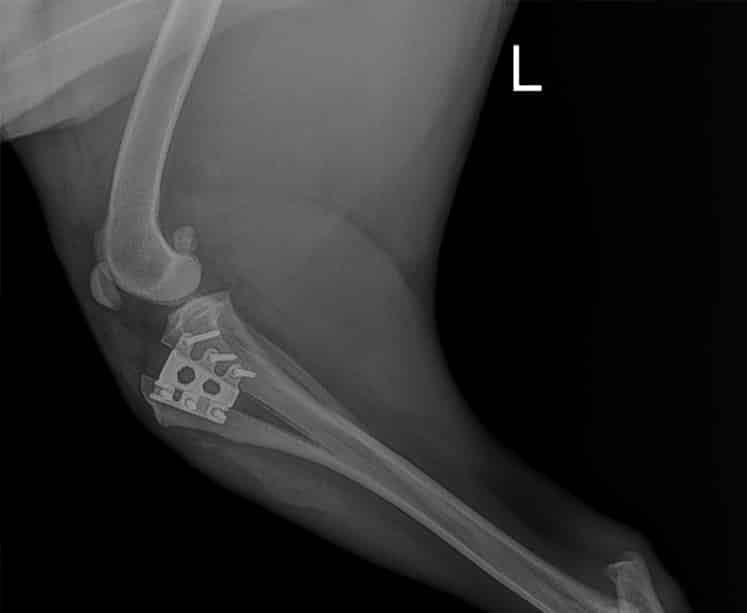
At Westlakes Veterinary Hospital, we take animal x-rays and ultrasounds.
Ultrasonography and digital x-rays are essential to making thorough diagnoses and effective treatment.
Our clinic has recently invested in the top-of-the-range medical machines, which give us clear, in-depth and accurate imaging of the internal anatomy. There is little-to-zero discomfort for your animal during these examinations, although areas of hair may have to be clipped and coupling jelly applied between the transducer and your pet’s skin.
In some cases, sedation or general anaesthesia may be required to keep the patient still, while taking multiple images. For more information, call our team today on 02 4959 5766.


During fracture repair surgery, our operating team use x-rays to ensure the plates and pins are placed and fitted optimally on the limb. As each fracture and bone is unique, tailoring of the pins and plates is performed as necessary to ensure the correct angles are achieved for the best outcome.
A seizure can have several manifestations, from a far-away look or twitching in one part of the face to a dog falling on its side barking, clenching and unclenching its teeth, urinating, defecating and paddling all four limbs. Seizures can vary in time between seconds to hours.
First, do not panic! When a dog is having a seizure, they are not fully conscious. Keep your dog as quiet as possible and prevent them from hurting themselves. Loud or sharp noises may prolong the seizure or make it worse. Other animals in the household may become frightened or feel threatened by the seizing dog. Remove them from the immediate area for everyone’s safety. If you speak to your dog while it is experiencing a seizure, it may comfort them and can help smooth the recovery period. Never put your hands near the dog’s mouth as they may involuntarily bite you. Remember: your dog is not themself right now and will do things they would never normally do.
Call us to have them examined. Most seizures only last seconds to minutes. If the seizure lasts more than 30 minutes, permanent brain damage can occur if the seizure is not stopped and so emergency treatment is needed if seizing persists for more than a few minutes.
No. There are a number of conditions that can cause seizures or seizure like episodes. Sometimes these can be isolated events. However, even if your dog has just had a one-off seizure, a complete physical and neurological examination is still in order. We may even need to perform blood tests to check your dog’s body and organs are working as they should be.
Yes – if you believe your dog is having a seizure, it’s important to note all the details so that you can accurately describe them to us.
Generalised Seizure: This type of seizure can be grand mal (a serious form of seizure with muscle spasms and prolonged loss of consciousness) or mild. The grand mal seizure is also known as a tonic-clonic seizure because it typically has two phases. In the tonic phase, which usually lasts 10-30 seconds, the dog falls, loses consciousness and extends their limbs rigidly. Breathing may also stop (this is known as apnea). It is followed by the clonic phase, in which the dog may start paddling their legs and/ or appear to be chewing. Other signs that may occur during these stages are dilation of the pupils, salivation, urination and defecation. The mild seizure involves little to no paddling or extension of limbs and usually no loss of consciousness.
Partial Seizures: Movements are restricted to one area of the body, such as muscle jerking, movement of one limb, turning the head or bending the body to one side or facial twitches. A partial seizure can progress to (and be mistaken for) a generalized grand mal seizure but if the seizure starts with one specific area of the body, it’s a partial seizure.
Complex Partial Seizure: These seizures are associated with bizarre or complex behaviours that are repeated throughout each seizure. People with complex partial seizures experience distortions of thought, perception or emotion (usually fear), sometimes with unusual sensations of sound, smell, hallucinations or taste. If dogs experience the same things, it may explain the lip smacking, chewing, fly biting, aggression, vocalisation, hysterical running, cowering or hiding in otherwise normal animals. Vomiting, diarrhoea, abdominal distress, salivation, blindness, unusual thirst or appetite and flank biting are other signs. There is an obvious lack of awareness, though usually not a lack of consciousness. Abnormal behaviours may last minutes or hours and can be followed by a generalised seizure.
Cluster Seizures: These are multiple seizures within a short period of time with only brief periods of consciousness in between. There may be as few as two seizures in a 30-minute period. The time between seizures may be as brief as 5 to 10 seconds or as long as 4 to 6 hours. They may be confused with status epilepticus.
Status Epilepticus: Status can occur as one continuous seizure lasting 30 minutes or more, or as a series of multiple seizures in a short time with no periods of normal consciousness. It can be difficult to distinguish status epilepticus from frequent cluster seizures, but both are life-threatening emergencies. Most status patients usually suffer from generalised tonic-clonic (grand mal) seizures. Though status epilepticus can occur with either primary or secondary epilepsy, it may also suddenly arise in dogs with no previous history of seizures, especially in cases of traumatic brain injury, toxins or disease.
Petit Mal Seizure (Absence Seizure): This type of seizure is rare in dogs. A dog having a petit mal seizure may tremble, arch his back or shake his head, have difficulty standing and/ or drool.
| Monday – Friday | 9:00 – 18:00 |
| Saturday | 8:00 – 12:30 |
| After Hours | AREC |